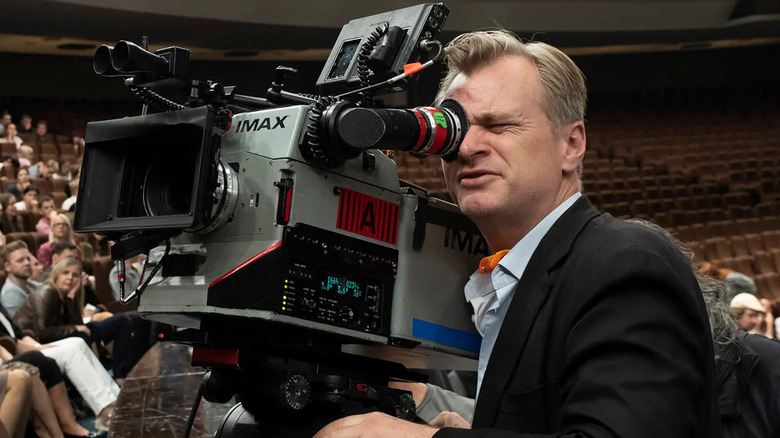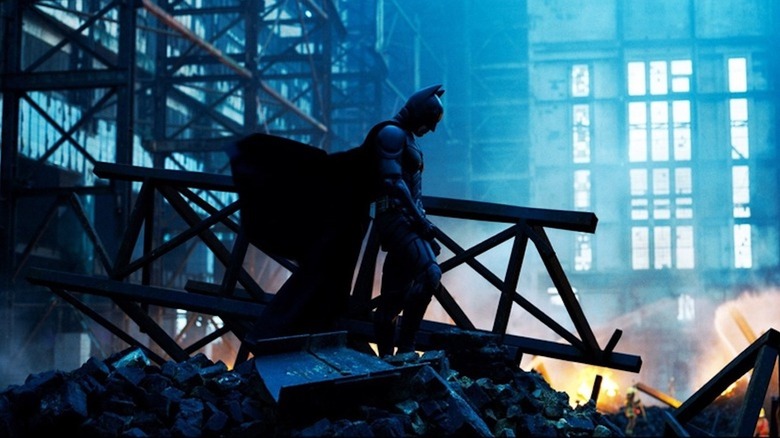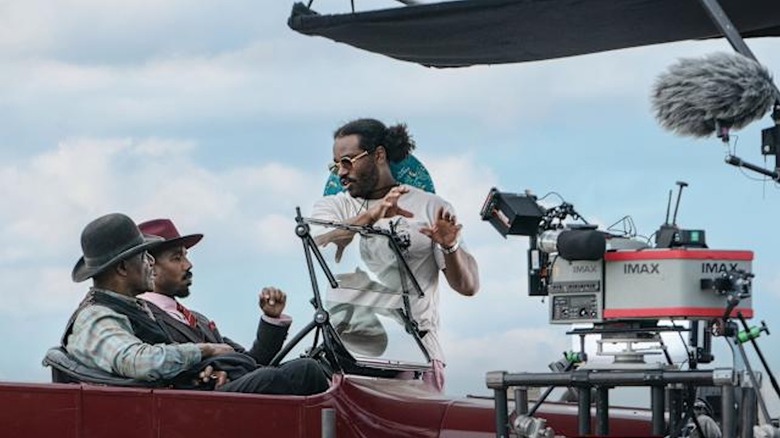Christopher Nolan's Plan To Save Movie Theaters Could Be Just Ambitious Enough To Work
As the number of movie theaters equipped with film projectors continues to dwindle, Christopher Nolan's ongoing crusade to save the celluloid format might seem downright quixotic. While many top filmmakers, along with Nolan, still shoot their movies on (mostly) 35mm film stock (e.g. Quentin Tarantino, Celine Song, Ryan Coogler, Paul Thomas Anderson, and Rian Johnson), to get the full effect of the rich, textured images, you really need to see their work projected on film. This is doable if you live in a metropolis like New York City or Los Angeles, but is virtually impossible outside of major media markets.
The conventional wisdom amongst studios and exhibitors is that film projection is dead. Bringing it back would require theater owners to not just purchase and install new equipment but also train some employees in the dying art of film projection. Given the imperiled state of theatrical exhibition (even when theaters are not being actively destroyed a la screenings of "A Minecraft Movie"), it is accepted as a stone cold fact that there's not a chance in hell theater owners will explore this option, even on a single-market trial basis.
As a lifelong film lover who grew up watching movies on 35mm (and occasionally 70mm), I refuse to believe that we've seen the last of film projection in smaller markets. In fact, I think it's possible that exhibitors could be persuaded to build more IMAX houses, some of which would be capable of projecting honest-to-god film in the company's pure 15/70 format. I believe this because Nolan and Coogler have shown us there's a growing hunger for the big screen sensation. So, I am absolutely thrilled that Nolan is doubling down on his IMAX fetish by shooting his adaptation of Homer's "The Odyssey" entirely on new, less onerous IMAX cameras.
Behold the new, less noisy IMAX cameras!
According to The Hollywood Reporter, Nolan, fresh off his Oscar-winning "Oppenheimer," was keen to up the technical ante by shooting all of his next movie on IMAX cameras. As IMAX CEO Rich Gelfond said at a Cannes press event this week, "Chris called me up and said, 'If you can figure out how to solve the problems, [I] will make ['The Odyssey'] 100 percent in IMAX.' And that's what we're doing. He forced us to rethink that side of our business, our film recorders, our film cameras."
The biggest issues with shooting on IMAX 65mm cameras have been noise and a somewhat poky workflow. These new cameras, all of which are currently in Nolan's possession until he finishes shooting "The Odyssey," are 30-percent less noisy. Footage can also be turned around much more quickly, which means directors don't have to wait as long to watch dailies. If the cameras are up to snuff for a filmmaker as exacting as Nolan, this should mean they'll be ideal for all of his talented colleagues.
While this is excellent news for Nolan and everyone lucky enough to live within driving distance of one of the U.S.' 30 70mm IMAX theaters, is this really that big a deal for those of us who have to make do with digital IMAX houses? Absolutely. Because we already know there is a significant demand for true IMAX thanks to the box office sensation that is Ryan Coogler's "Sinners."
Make 70mm IMAX presentation akin to attending a rock concert
As /Film's Ethan Anderton wrote during the film's first week of release, "Sinners" offers an ecstatically heightened IMAX experience. Even the company's digital format is far more immersive than what you'll get from a regular ol' movie house (which is still plenty special in its own right, because this is a film that demands to be seen in a theater). But the pure IMAX presentation is, according to those fortunate enough to have seen it, utterly transcendent.
As a celluloid devotee, I'm not surprised. Again, the richness and texture of 70mm projection is untouchable (ditto the sound). Coogler encouraged audiences to see his film in IMAX if they could swing it, which led to off-peak sellouts in some cities. The film was doing such phenomenal business in IMAX that Warner Bros. is rereleasing it in 70mm this weekend. The only bummer here is that WB only struck 10 70mm prints (which is cruddy, considering that Universal struck 113 70mm prints of "Oppenheimer"), so most of the U.S., once again, won't have the pleasure of visiting Smoke and Stack's juke joint in the manner Coogler intended.
This is the state of play now, but it doesn't have to stay this way. I have to think exhibitors are taking notice of this demand for IMAX 70mm and running some numbers to see what, if anything, is financially feasible for them. Building new IMAX 70mm houses would cost them a ton in the short term, but it would surely pay off handsomely in the long term when people realize that there's no better format in which to watch a movie. Exhibitors are massively appreciative of what Nolan has done for them over the years; they should trust him (and Coogler), and move forward on the construction of at least a few new pure IMAX theaters. The pitch should be that seeing a film in this format is akin to attending a rock concert. (In fact, The Rolling Stones were way ahead of this notion when they shot "Stones at the Max" in 1991.)
The bad news is that they'll likely want to wait and see if this is just a momentary trend whipped up by a sui generis blockbuster. Additionally, we won't really know how effective these new IMAX cameras are until other directors get to use them. But for the first time in 25 years, I have real hope that film could make at least a small comeback domestically and, perhaps, globally. If anyone can kick off a celluloid renaissance, it's Christopher Nolan and Ryan Coogler.
You can check out "The Odyssey" when it hits theaters on July 17, 2026.


